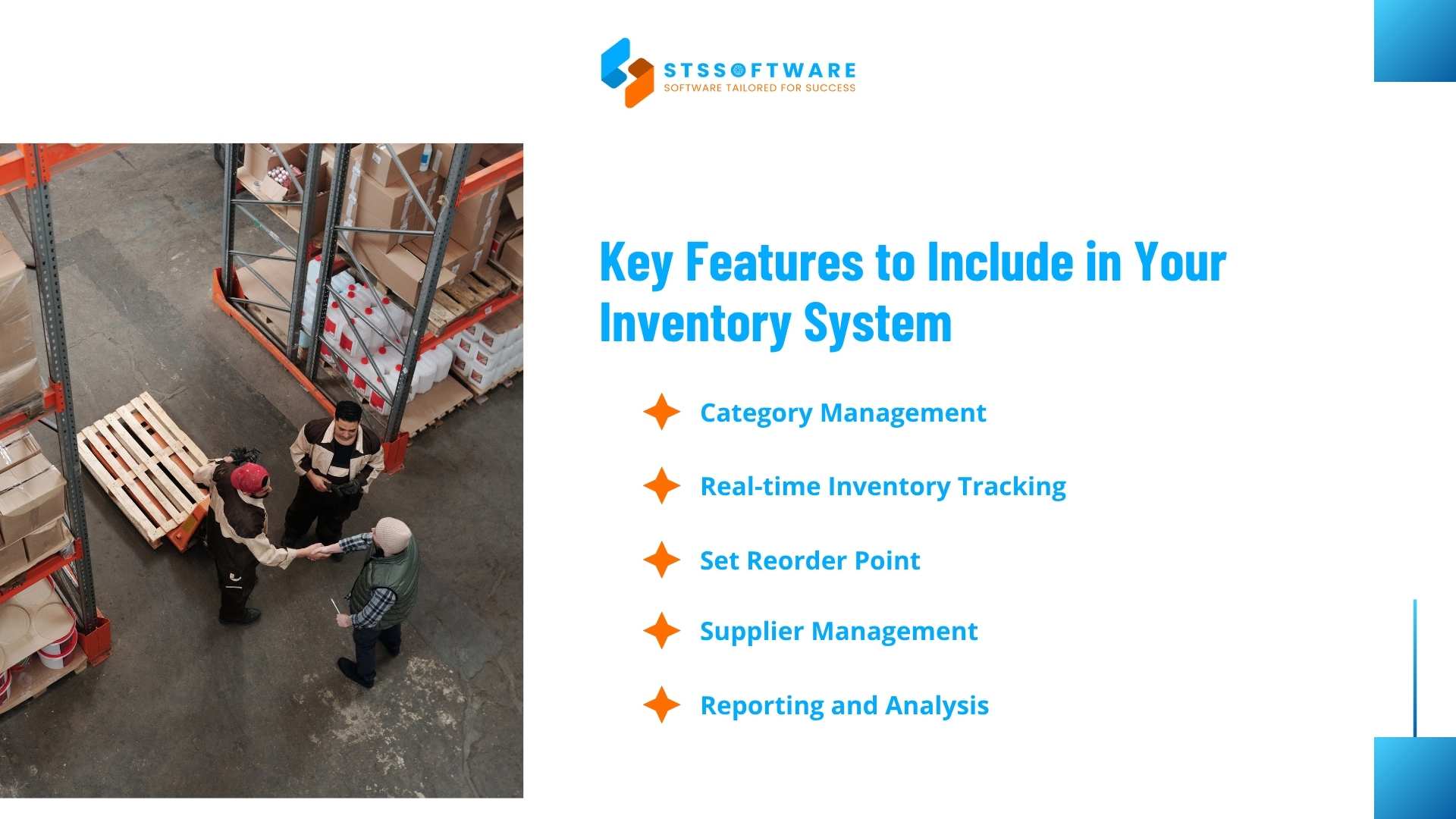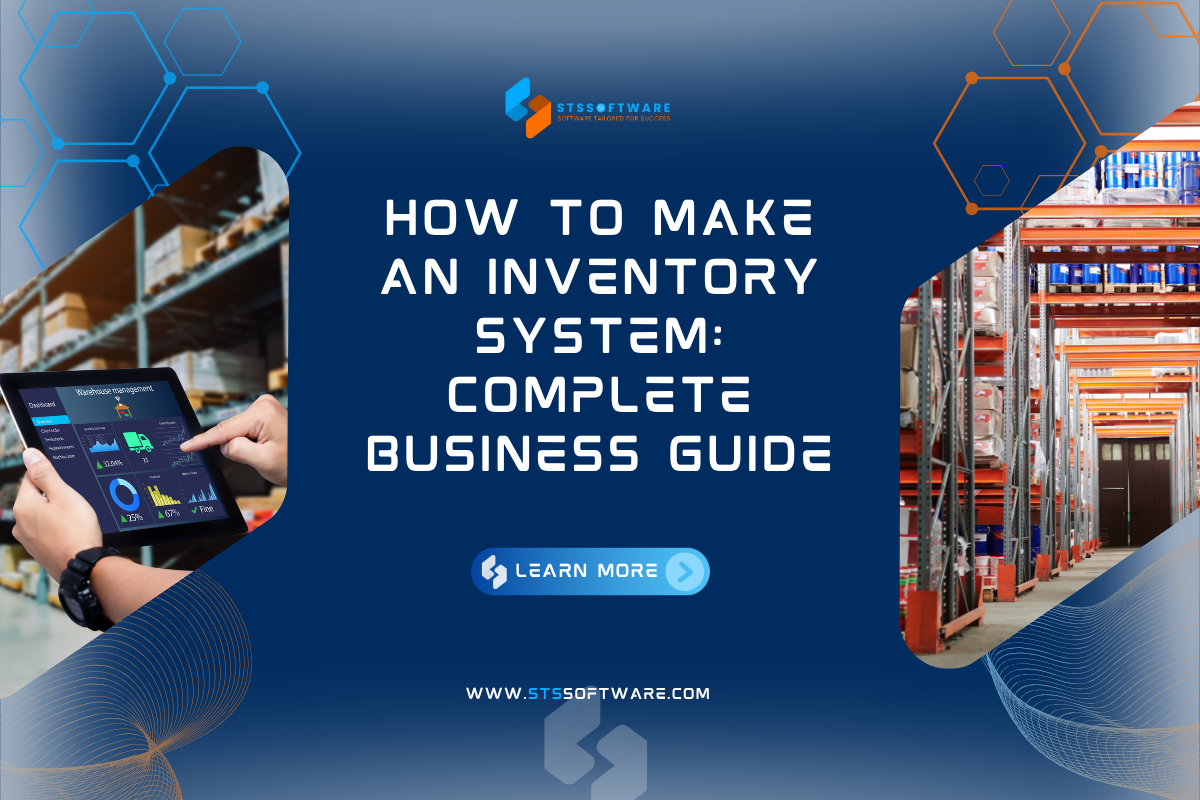Managing stock plays a key role in helping businesses save costs and increase profits. In today’s competitive market, inventory control directly impacts a company’s performance. Many small businesses still use spreadsheets or handwritten notes to track inventory. These manual methods often cause errors, losses, and inaccurate stock information. As a result, businesses face difficulties in managing goods effectively. This makes it urgent to build a proper inventory system.
Developing a complete warehouse management system can solve these problems. Such a system helps track stock accurately in real time. It also streamlines the import and export process. By reducing errors and waste, the system lowers operational costs. Ultimately, it improves the efficiency and productivity of the business.
In the article below, let’s learn in detail about how to make an inventory system with STS Software, from the initial preparation steps to notes when implementing in practice, to help businesses build an effective, sustainable warehouse management solution that is suitable for their business scale.
Understanding Inventory Management System Fundamentals
It can be said that businesses must first understand the key components of a modern inventory system. This type of system offers more than just quantity tracking. It helps control stock, optimize operations, and predict real-time demand effectively.
Typically, an effective inventory management system comprises the main components such as: product database, purchase – sale management tools, low-stock warning module, synchronization feature with sales or ERP, and capability of data analysis to support decision making. Properly designed inventory management software helps avoid shortages or excesses in inventories but also improves working business processes and significantly cuts warehousing costs.
The key differences between basic inventory tracking and comprehensive management are the ability to automate, integrate data across departments, and a systematic provision of timely information to activities such as purchasing, sales, finances, and logistics. So, don’t build your inventory system as just a tool. Aim for a flexible architecture that supports scalable, long-term business growth.
Key Features to Include in Your Inventory System

The focus on features needs to be absolute while taking up the inventory management software development for business operational efficiency and scalability. Spotting the features that are imperative for a business inventory system will help in developing resources optimally and will design a company, which can be used well both today and tomorrow. So, if you’re planning to build an inventory system, ensure your solution includes all the key features listed below:
- Category Management: Regulates how the grouping of products into a category, brand, SKU code, or other customized criteria will be made easier, more scientific, and more manageable easily.
- Real-time Inventory Tracking: It automatically updates the inventory data on item numbers within the system, goods that are either waiting for import or export, and warnings when the inventory is at a low level so that there is no shortage.
- Set Reorder Point: Pre-planning for importing goods by businesses would take place using this function, which will set predetermined minimum levels for the stock to be maintained, thus ensuring good flow of supply.
- Supplier Management: Store detailed supplier information, order history, and purchase-sale conditions, helping to improve relationships and order performance.
- Reporting and Analysis: Inventory statistics, product rotation, and trend analysis help managers make quick and accurate decisions.
Building these functions fully from the beginning increases the usefulness of the system. This boosts system value and supports future expansion or integration smoothly.
Step-by-Step Guide to Creating an Inventory System
How to set up an inventory system is not just about creating a warehouse management software, but a process that includes many stages with clear organization and direction. Every step—planning, design, coding, testing, and launch—matters in building an inventory system. If you are looking for how to make an inventory system effectively for your business, use the guide below to build a system tailored to your business. Specifically:
Requirements Gathering and Business Analysis
Firstly, start by defining the inventory system requirements clearly. Also, understand your current business processes in depth before development begins. Business analysis for inventory system helps ensure that the software is built based on real needs instead of just technical.
Steps to take:
- Interview stakeholders such as warehouse staff, accountants, sales managers.
- Map the current workflow and identify bottlenecks.
- Identify the key functions required, the data to be tracked, and the required output reports.
Database Design for Inventory Management
Next, an effective system must start with a solid foundation. That foundation is the inventory database design. The database architecture determines the ability to store, retrieve, and process inventory information accurately and quickly.
Factors to note in the inventory data structure:
- Design the main tables, like: Products, Categories, Suppliers, Orders, Import/Export.
- Determining the relations between the tables to allow for seamless data interconnectivity and integrity.
- Optimize the database to handle thousands of records without slowing down the system.
User Interface Considerations
Thirdly, much power in the system does not put an end to ineffectiveness when the interface becomes difficult for a user to grasp. Therefore, the inventory system UI design needs to aim an overt simplicity, intuitiveness, and accessibility for all users-from warehouse staffs to managers.
Principles when designing user-friendly inventory software:
- Minimal interface, displaying the most necessary information.
- Clear navigation, easy to learn – no need for in-depth training.
- Provide quick search, data filtering, and easy-to-use custom reports.
Integration with Other Business Systems
Finally, to optimize performance and automate processes, the inventory management system needs the ability to integrate the inventory system with other software. Depending on the business model, businesses can integrate the system with:
- Accounting system (ERP integration): automatically synchronize orders, invoices, and inventory with accounting.
- E-commerce platform (e-commerce integration): update inventory in real time between the warehouse and online store.
- Shipping tools: support order processing and automatic printing of delivery notes.
Custom Development vs. Ready-Made Solutions
When choosing a warehouse management system, one major decision is choosing between custom-built or off-the-shelf inventory solutions. In contrast, each option suits different needs. Both sides have their own advantages and disadvantages; the right choice will depend on the size of the business, budget, and long-term goals. Here is a comparison chart for visualization:
| Criteria | Custom Inventory System | Off-the-Shelf Inventory Solutions |
| Customization | High – custom design, flexible to internal processes | Low – only available features available |
| Scalability | Easy to scale to future business size | Limited by fixed software structure |
| Initial Cost | High – due to investment in inventory management software development | Low – paid per package or subscription |
| Implementation Time | Longer – due to development and testing from scratch | Fast – available immediately after purchase or subscription |
| Support and Maintenance | Depends on the developer, can be more flexible | Based on vendor policy, usually fixed |
| Long-term ROI | High if system operates efficiently and is well scaled | May be lower if demand exceeds software capabilities |
Technologies and Tools for Building an Inventory System
Programming Languages and Platforms
- Node.js: Suitable for systems that need to process data in real time with fast speed and high performance.
- Python: Suitable for applications that require complex data processing or integrated reporting analysis.
- Java: Ideal for large-scale enterprise systems that need to ensure stability and security over a long period of time.
Database Management System
- PostgreSQL: A robust open-source database designed to manage applications with intricate data models.
- MySQL: An established choice for fast deployment, rich documentation, and a huge community support base.
- MongoDB: Suitable for systems that require high flexibility in data structures, especially when the data is not entirely in traditional tables.
User Interface and Front-end
- React.js: Commonly chosen for creating interactive user interfaces that improve engagement.
- Vue.js: Easy to learn, lightweight, and efficient for small and medium businesses that require a fast-deployed and less complex system.
Development and Deployment Support Tools
- Git + GitHub/GitLab: Source code version control to promote team spirit and easier to track changes.
- Docker: Facilitates packaging the entire application into containers for consistent deployment across multiple environments.
- Jenkins or GitHub Actions: will help create an automated CI/CD process for automatic software testing and deployment along with no manual dependencies.
Approach and Architecture
- Microservices architecture helps break applications down into independent modules, thereby making them easy to maintain and extend.
- The communication is made via RESTful API or GraphQL, which allows the system to position itself for scalability and sustained growth in the future.
- The cloud-native deployment on AWS, Azure, or GCP allows the system to position itself for scalability and sustained growth in the future.
Common Challenges in Inventory System Implementation
Resistance from internal staff
- For example: A logistics company when switching from Excel to warehouse management software encountered resistance from long-term employees, because they were not familiar with the software and feared being judged on their performance.
- Solution: Businesses should organize step-by-step training, combine testing and internal communication to create consensus.
Lack of understanding of business processes
- For example: A retail chain chooses inventory software that does not support batch or expiration date management – essential for food products.
- Solution: Conduct a thorough business analysis, consult relevant departments before choosing or building the system.
Difficult system integration
- Solution: Prioritize software with strong integration capabilities via API, or hire a technical team with experience in cross-platform system integration.
Lack of technical resources or budget
- Solution: Develop a step-by-step implementation roadmap, prioritizing core features first; and choose the right software model (e.g. SaaS to save on initial costs).
Unstandardized input data
- For example: A company has three ways to name the same item (“White Shirt”, “White SM”, “White Somi”), which makes it impossible to track inventory properly.
- Solution: Standardize the catalog before entering the system, authorize data entry, and periodically check.
Why Choose STS Software as Your Partner for How to Make Inventory System
If you are looking for how to make an inventory system suitable for your business, choosing the right technology partner will be a key factor to ensure success. STS Software is the unit with full capacity and experience to accompany you in the process of inventory management software development, from the stage of analyzing needs to deploying, supporting and expanding the system in the long term.
Understanding Specific Business Problems
Firstly, STS Software not only builds software, but also focuses on understanding the specific operating processes of each business. Thanks to that, the solutions provided are always highly practical and flexible according to the actual operating model – something that packaged solutions can hardly meet.
Custom Solution Development Capability
Next, we also have a team of experienced engineers in inventory management software development, capable of developing custom inventory solutions from basic features such as import – export – inventory management, to advanced functions such as locating inventory locations, automatically calculating reorder points, or integrating the system with e-commerce platforms, accounting software.
Long-term Support Commitment
In addition to this, STS Software not only delivers software but also commits to accompanying after implementation, from system maintenance, expanding features according to arising needs, to periodic technical support. This helps businesses develop with peace of mind without worrying about the burden of technology.
Whether you are a retail chain, distributor, manufacturer or e-commerce company, STS Software is always ready to provide in-depth advice on how to make an inventory system suitable for your specific scale and growth goals.
Conclusion: Taking the Next Steps in Your Inventory Management Journey
Building an inventory management system is not only a technological upgrade, but also a foundation for businesses to optimize operations and grow sustainably. During the process of learning how to set up an inventory system, you need to carefully consider your actual needs, clearly define your goals, and especially choose the right implementation partner.
In short, for the inventory system development process to be highly effective, businesses should:
- Comprehensively assess internal needs and processes, avoid mechanically copying external solutions.
- Identify essential features needed, such as batch inventory management, low inventory warnings, integration with sales or accounting systems.
- Make a realistic implementation plan, including costs, time, and future scalability.
- Look for a reliable software development partner with experience in custom solutions and a good understanding of industry specifics.
If you are at the first step of this journey and want specific advice on how to set up an inventory system that suits your business model, STS Software is the partner you can trust. With deep expertise and long-term commitment, we are ready to work with you to implement an effective inventory system – from the first design to the actual operation.



